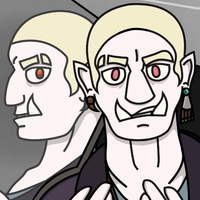Profile
/ɔrk/
Orcs | Terrestrial | Hominid
Physical:
Appearance:
On average, orcs stand anywhere from 5'9" to 7'6" tall. They have hair colors often likened to the tones of animal hide (excluding blondes), skin tones in shades of greens, blues/purples and teals, and relatively muted eye colors alongside red and yellow. They tend to store muscle and fat in extremes.
Facets of orc appearances such as height, skin tone, hair texture/color, and eye color do not seem to vary heavily according to region. Orcs with green skin are more common than others, and green skin is more often inherited than teal from differing parents. Orcs with blue skin can only be born from two parents with blue skin. Hair colors and textures also greatly vary, though blonde and white hair isn't seen outside of pigment issues.
Orcs are susceptible to a few genetic disorders, including ones which impact one's appearance such as albinism, dwarfism, heterochromia, and vitiligo. Pigment-based disorders are especially common. Sexual hormone-based disorders are rare. Many unseen disorders (harmless or not) often go undiagnosed and are passed down, especially among smaller communities and settlements. Occasionally, such conditions can cause infertility, mainly due to their nature. Lycanthropy is a widespread and commonly known genetic disorder among orcs, but is considered especially distinct from others.
Distinguishing Features:
Orcs have variable hair growth across the population. While most are capable of growing facial hair, the ability to which it can be grown varies. Some individuals can only grow sideburns which reach slightly below the ear lobes and, if any, very sparse hair on the rest of the face, while others can grow it in patterns which resemble the hirsute nature of dwarves. Most fall in between in their ability. Body hair is present in varying degrees of thickness, but regardless of color is usually dense enough to be noticeable. Hair loss on the scalp is known to occasionally occur with age. Among orcs, dense facial hair growth is generally considered masculine (more present in male-assigned, male-identifying individuals) whereas a lack or sparseness thereof is generally considered feminine (more present in female-assigned, female-identifying individuals). However, such distinctions or expectations are almost entirely forgone on this continent.
Orcs possess two lower canine teeth (sometimes referred to as "tusks") which protrude from the mouth. These teeth fully grow in at three years old; the beginning of their growth coincides with the end of breastfeeding, which can cause the set to be fully grown earlier in an infant's life. Unlike deciduous teeth, these canines are permanent. Tusks continue to slowly grow throughout an orc's life, often being maintained through natural friction and self-care to a healthy degree and length. While rarely misaligned to an unhealthy degree, there are dental practices available to correct misaligned teeth. Overgrown tusks which interfere with everyday activities can be painlessly trimmed to a length of about an inch outside of the mouth without issue. Tusks which are removed or lost entirely do not grow back, but prostheses and false teeth are available.
Orcs can either have unpointed ears resembling a human's, or slightly pointed ears which resemble some elves'. One variant does not seem more common than the other.
Like humans, orcs are susceptible to lycanthropy. Read more about werewolves here.
Compatibility:
Orcs cannot have children with any other species.
Cultural:
Religion:
text text text
Gender Expression:
On this continent, the majority of orcs consider themselves genderless. Exceptions almost exclusively occur in orcs who are raised in a different culture (such as being from a different continent or being raised by non-orcs/non-anthritilians). Androgyny is common, but not necessarily expected.
Sexualities tend to go undefined among orcs; either an individual is attracted to another, or they are not. However, several orcs do identify preferences when it comes to gendered individuals, and may choose to define a sexuality in regards to that aspect of themselves. Taking on different, non-orc/non-anthritilian nonbinary labels is also seen. Such labels are mostly accepted among orcs, but some are opposed to the practice.
While orcs are traditionally named at birth, there is no stigma against changing one's name, even multiple times throughout one's life. It is traditional to retain the surname of one parent (generally whichever parent birthed them, but surrogacy, adoption, and personal choice can change this), and whether they modify the surname after marriage is up to personal choice.
There is a large variety of pronouns which orcs use, and the introduction of new sets has been commonplace over the years. Young orcs are often referred to as "e/er/em" until expressing a different preference, but many adults choose to continue using the set. Other sets include he/him, she/her, they/them, it/its, ze/zir, thon/thons, ae/aer, xe/xyr, and more. Others choose to entirely forgo using pronouns when being referred to.
Medical practices commonly associated with gender confirmation are common among orcs, and come without stigma. Not all individuals strive for androgyny.
Clothing, hair styles, and facial hair are not considered to be gendered.

